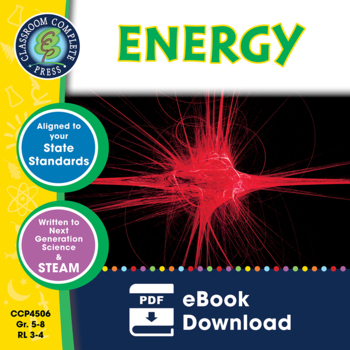Energy Gr. 5-8
- PDF
Also included in
- You don't have to be a rocket scientist to understand matter and energy with our Physical Science 3-book BUNDLE. About this Resource: Students discover what matter is with Properties of Matter. Identify atoms, particles and molecules before exploring the three states of matter. Experiment with photoPrice $23.96Original Price $44.85Save $20.89
Description
Unlock the mysteries of energy. Our resource demonstrates how energy is more than "the ability to do work".
About this Resource:
Learn about all the different kinds of energy. Dissect mechanical energy by identifying the different points on a roller coaster as using kinetic or potential energy. Find out how an object's thermal energy is calculated from its kinetic energy. Understand that amplitude, wavelength and frequency are all part of sound waves, and use these terms to correctly label one. Take a look at the electromagnetic spectrum as you see all the colors of light energy. Explore other forms of potential energy from nonrenewable and renewable sources. Finally, measure the speed of sound in a group experiment.
Aligned to the Next Generation Science Standards and written to Bloom's Taxonomy and STEAM initiatives, additional hands-on experiments, crossword, word search, comprehension quiz and answer key are also included.
************************************************************************
View Similar Titles:
► Atoms, Molecules & Elements Gr. 5-8
► Properties of Matter Gr. 5-8
► The Nature of Matter - BIG BOOK Gr. 5-8
************************************************************************
Check out our sister TPT shops:






